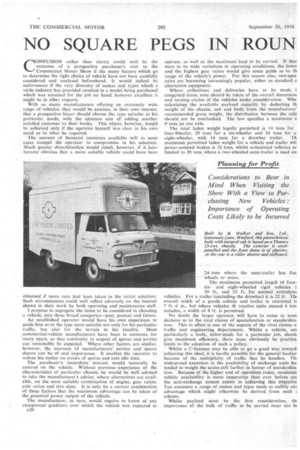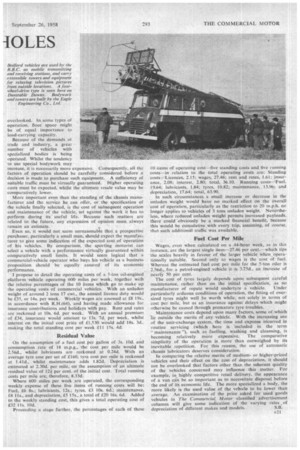NO SQUARE PEGS IN ROUN IOLES
Page 134

Page 135

If you've noticed an error in this article please click here to report it so we can fix it.
CONFUSION rather than clarity could well be the outcome of a prospective purchaser's visit to the Commercial Motor Show if the many factors which go to determine the right choice of vehicle have not been carefully considered and analysed beforehand. It would indeed be unfortunate if the very diversity of makes and types which a virile industry has provided resulted in a model being purchased which was unsuited for the job on hand, however excellent it might he in other respects.
With so many manufacturers offering an extremely wide range of vehicles, they would be anxious, in their own interest, that a prospective buyer should choose the type suitable to his particular needs, with the ultimate aim of adding another satisfied customer to their books. This object, however, would be achieved only if the operator himself was clear in his own
mind as to what he required. . , " The amount of financial resources available will in most cases compel the operator to compromise in his selection. Much greater dissatisfaction would result, however, if it later became obvious that a more suitable vehicle could have been obtained if more care had been taken in the initial selection. Such circumstances could well reflect adversely on the interest shown in their work by both operating and maintenance staff.
I propose to segregate the items to be considered in choosing a vehicle, into three broad categories—past, present and future.
An established operator would have his own experience to guide him as to the type most suitable not only for his particular traffic, but also for the terrain in his locality. Most commercial-vehicle manufacturers have been in existence for many years, so that continuity in respect of spares and service can reasonably he expected. Where other factors are similar, however, the nearness Of manufacturers' service and spares depots can be of real importance. It enables the operator to reduce his outlay on stocks of spares and cuts idle time.
The purchaser's immediate interest would naturally be centred on the vehicle. Without previous •experience of the characteristics of particular chassis, he would be well advised to take the manufacturer's advice, where alternatives are available, on the roost suitable combination of engine, gear ratios, axle ratios and tyre sizes. It is only by a correct combination of these factors that the maximum advantage can be taken of the potential power output of the vehicle.
The manufacturer, in turn, would require to know of any exceptional gradients over which the vehicle was expected to P20 operate, as well as the maximum load to be carried. If ther were to be wide variations in operating conditions, the lowe and the highest gear ratios would give some guide as to th range of the vehicle's power. For this reason also, two-spec axles are becoming increasingly popular, either as standard a alternative equipment.
Where collections and deliveries have to be made i congested areas, note should be taken of the overall dimension and turning circles of the vehicles under consideration. Whe calculating the available payload capacity by deducting th . weight of the chassis, cab and body from the manufacturer' recommended gross weight, the distribution between the axle should not be overlooked. The law specifies a maximum a 9 tons on one axle.
The total laden weight, legally permitted is 14 tons for four-fteeler, 20 tons for a six-wheeler and 24 tons for a: eight-wheeler, with 14 tons for a drawbar trailer. Th maximum permitted laden weight for a vehicle and trailer wit] power-assisted brakes is 32 tons, whilst articulated vehicles ar limited to 20 tons where a two-wheeled semi-trailer is used an 24 tons where the semi-trailer has fou wheels or more.
The maximum permitted length of foursixand eight-wheeled rigid vehicles 30 ft., and 35 ft. for normal articulates vehicles. For a trailer '(excluding the drawbar) it is 22 ft. Th€ overall width of a goodsvehicle and trailer is restricted tc 7 ft. 6 in., but where vehicles d'r tractive units exceed 4 ton: unladen, a width of 8 ft. is permitted.
No doubt the larger operator will have to come to somc decision as to the rival claims of specialization or standardiza tion. This in effect is one of the aspects of the rival claims o traffic and engineering departments. Whilst a vehicle, am particularly a body, tailor-made for a particular job, shank give maximum efficiency, there must obviously be practica limits to the adoption of such a policy.
Whilst a C-licensee may be able to go a good way toward: achieving this ideal, it is hardly possible for the general haulier because of the multiplicity of traffic that he handles. Thc widespread extension in the availability of exchange units ha: tended to weight the scales still further in favour of standardiza. tion. Because of the higher cost of operation today, maximun vehicle availability is more imperative than ever before am the unit-exchange system assists in achieving this objective Too extensive a range of makes and types tends to nullify an advantage which might otherwise be derived from such scheme.
Whilst payload must be the first consideration, thi importance of the bulk of traffic to be carried must not In overlooked. In some types of operation, floor space might be of equal importance to load-carrying capacity.
Because of the demands of trade and industry, a great number of vehicles with specialized bodies is being operated. Whilst the tendency to use special bodywork may increase, it is necessarily more expensive. Consequently, all the factors of operation should be carefully considered before a decision is made to purchase such equipment, A sufficiency of suitable traffic must be virtually guaranteed. Higher operating costs must be expected, whilst the ultimate resale value may be comparatively lower.
More important even than the standing of the chassis manufacturer and the service he can offer, or the specification of the vehicle finally selected, is the cost of subsequent operation and maintenance of the vehicle, set against the work it has to perform during its useful life. Because such matters are related to the future, any expression of opinion must always remain an estimate.
Even so, it would not seem unreasonable that a prospective purchaser, particularly a small man, should expect the manufacturer to give some indication of the expected cost of operation of his vehicles. By comparison, the sporting motorist can select a vehicle with a performance virtuaJly guaranteed within comparatively small limits. it would seem logical that a commercial-vehicle operator who buys his vehicle as a business proposition should be equally assured of its economic performance.
I propose to detail the operating costs of a 5-ton oil-engined platform vehicle operating 600 miles per week, together with the relative percentages of the 10 items which go to make up the operating costs of commercial vehicles. With an unladen weight of around 2 tons 17 cwt., the annual licence duty would be £35, or 14s. per week. Weekly wages are assessed at £8 19s., in accordance with R.H.(64), and having made allowance for insurance contributions and holidays with pay. Rent and rates are reckoned at 10s. 6d. per week. With an annual premium of £34, insurance would amount to 13s. 7d. per week, whilst interest on the initial cost price of £1,530 would add I8s. 3d.. making the total standing cost per week £11 I5s. 4d.
Residual Value
On the assumption of a fuel cost per gallon of 3s. 10d. and consumption rate of 18 m.p.g., the cost per mile would be 2.56d., whilst lubricants are reckoned at 0.24d. With an average tyre cost per set of £160, tyre cost per mile is reckoned at 1.41d., whilst maintenance adds 1.82d. Depreciation is estimated at 2.30d. per mile, on the assumption of an ultimate residual value of 12i per cent. of the initial cost. Total running costs per mile are, therefore, 8.33d.
Where 600 miles per week are operated, the corresponding weekly expense of these five items of running costs will be: Fuel, £6 8s.; lubricants, 12s.; tyres, £3 10s. bd..; maintenance, £4 Its., and depreciation, £5 15s., a total of £20 16s. 6d. Added to the weekly standing cost, this gives a total operating cost of £32 I Is. 10d.
Proceeding a stage further, the percentages of each of these 10 items of operating cost—five standing costs and five running costs—in relation to the total operating costs are: Standing costs—Licences, 2.15; wages, 27.46; rent and rates, 1.61; insurance, 2.08; interest, 2.80; total, 36.10. Running costs-Fuel, 19.64; lubricants, 1.84; tyres, 10.82; maintenance, 13.96; and depreciation, 17.64; total, 63.90.
In such circumstances a small increase or decrease in the unladen weight would have no marked effect on the overall cost of operation, particularly as the restriction to 20 m.p.h. no longer applies to vehicles of 3 tons unladen weight. Nevertheless, where reduced unladen weight permits increased payloads.. there could obviously be a marked financial benefit, because this would be cumulative .With every trip, assuming, of course, that sun additional traffic was available.
Fuel Cost Per Mile
Wages, even when calculated on a 44-hour week, as in this instance, are the largest single item-27.46 per cent.—which tips the scales heavily in favour of the larger vehicle When operationally suitable. Second only to wages is the cost of fuel. Whereas the estimated fuel cost per mile for the 5-ton oiler is 2.56d., for a petrol-engined vehicle it is 3.75d., an increase of nearly 50 per cent.
The cost of tyres largely depends upon subsequent careful maintenance, rather than on the initial specification, as no manufacturer of repute would undertyre a vehicle. Under particularly arduous conditions of operation, the fitting of oversized tyres might well be worth while, not solely in terms of cost per mile, but as an insurance against delays which might otherwise be caused throuth premature tyre troubles.
Maintenance costs depend upon many factors, some of which lie outside the merits of any vehicle. With the increasing use of the unit-exchange system, the time and expense incurred in routine servicing (which here is included in the term " maintenance "), such as -fuelling, washing and cleansing, is becoming relatively more expensive. The comparative simplicity of the operation is more than outweighed by its inevitable repetition. For this reason, the use of automatic chassis lubricators deserves consideration.
In comparing the relative merits of mediumor higher-priced vehicles and their effect on the cost of depreciation, it should not be overlooked that factors other than the inherent quality of the vehicles concerned may influence this matter. For example, in highly competitive retail delivery, the appearance of a van ea-7n be so important as to necessitate disposal before the end of its economic life. The more specialized a body, the more likely is the used value of the vehicle to be lower than average. An examination of the price asked for used goods vehicles in The Commercial Motor classified advertisement columns will give some indication of the varying rates of
depreciation of different makes and models. S.B.












































































































































































































































































































































